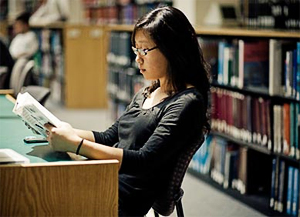SDSU Continuation Rates at All-Time High
More than 88 percent of freshmen continue on to their sophomore year.

More than 88 percent of SDSU freshmen continue on to their second year, the highest continuation rate in San Diego State University history.
Among freshmen who attended classes in 2010, 88.3 percent are enrolled again this fall, a significant increase from the previous year when 82.3 percent of freshmen continued on to their second year, according to the most recent campus census that was completed this month.
For students of color, 87.4 percent of freshmen who enrolled in fall 2010 are enrolled in their second year this fall, up from 81.5 percent the previous year. Continuation rates have increased steadily over the past several years. In fall 2007, 78 percent of new freshmen continued on to their second year.
Eliminating the achievement gap
“What is extraordinarily important about these data is not only that our continuation rate is well above the comparable national average, but that we have eliminated the so-called ‘achievement gap’ for students of color,” said SDSU Provost Nancy Marlin.
In fall 2010, SDSU had 2,958 new resident freshmen with an average high school GPA of 3.63 and average SAT score of 1083 (math and verbal only). Of those, 55 percent were students of color.
This fall, SDSU is even more diverse with 57.2 percent of resident freshmen enrollees considered students of color. Of those, more than 30 percent are Hispanic — the highest percentage of Hispanic students ever.
The improvement in continuation rates portends additional progress in improving graduation rates, Marlin explained. SDSU had the largest improvement in graduation rates in the nation in the most recent six-year period, improving from 44 percent in 2003 to 61 percent in 2008. SDSU’s current six-year graduation rate is 65.7 percent.
Getting freshmen started early
A number of programs can be credited for helping accelerate the increase in continuation rates, such as Summer Bridge and the Early Start Program. Both programs enroll students in a special session the summer prior to the start of their freshman year and help them become more academically prepared for the rigor of college coursework.
Early Start enrolls local students who need remediation in math and/or writing and Summer Bridge is for all new Educational Opportunity Program (EOP) students.
“Early Start students clear remediation needs, and at the same time, they learn the skills that can help them succeed in all of their college-level courses,” said Glen McClish, chair of SDSU’s Department of Rhetoric and Writing Studies and director of the Early Start Program.
Participants in Early Start and Summer Bridge often end up having higher GPAs, take more units and are less likely to go on academic probation or be disqualified than similarly prepared freshmen who do not complete the program.
“These programs also serve as an easier transition from high school to college,” McClish said. “After spending five weeks in the program, students know their way around campus, building their confidence and comfort level so they are better acclimated when the fall term begins.”
Currently, Early Start is required for all local freshmen who do not meet math and/or writing testing requirements at admission. But next summer, the program will be required for both local and non-local freshmen with English and/or math remediation requirements, not just at SDSU, but throughout the California State University system.
Academic benefits to campus living
An increase in the percentage of freshman students living on campus may also have contributed to the continuation rate increase. Studies have shown that students who live on campus are more likely to continue on to their second year, are less likely to go on academic probation and graduate at a faster pace than students who do not live on campus.
Residential learning communities link the living environment with specific academic experiences, helping freshmen students make connections between life inside and outside the classroom. More than 800 students are currently participating in 16 living-learning communities such as:
- Science, Technology and Math
- Social Activism and Global Environments
- Emerging Leaders
“The combination of taking classes and living together doesn’t change what you learn, but how you learn,” said Christy Samarkos, director of Residential Education. “The living-learning communities enhance the educational experience by introducing academic resources into the living environment.”



